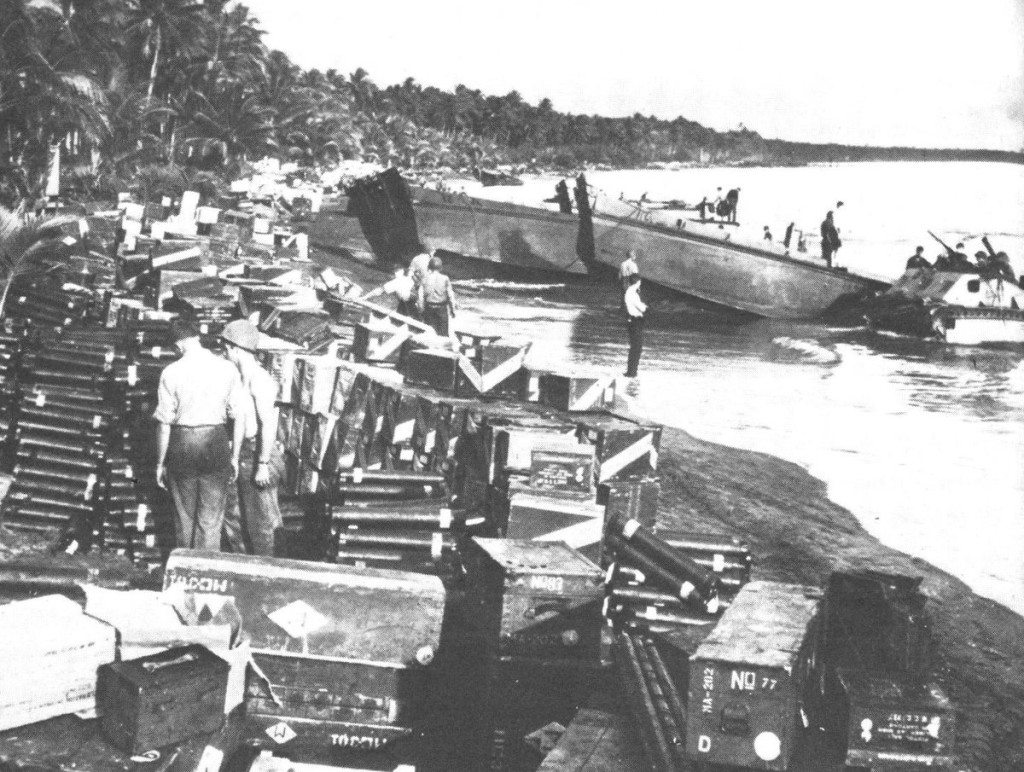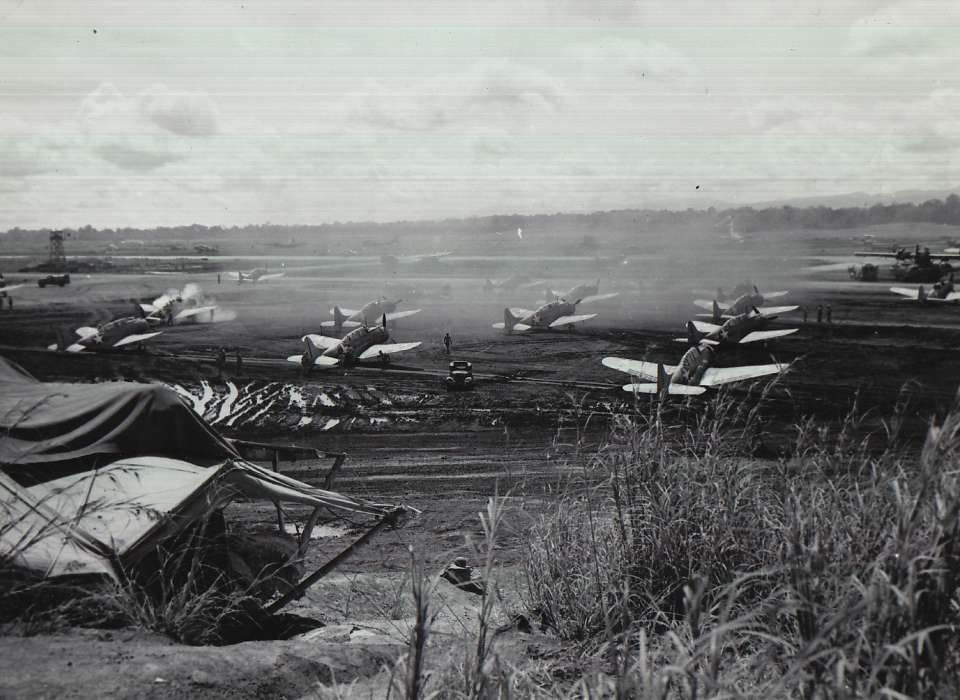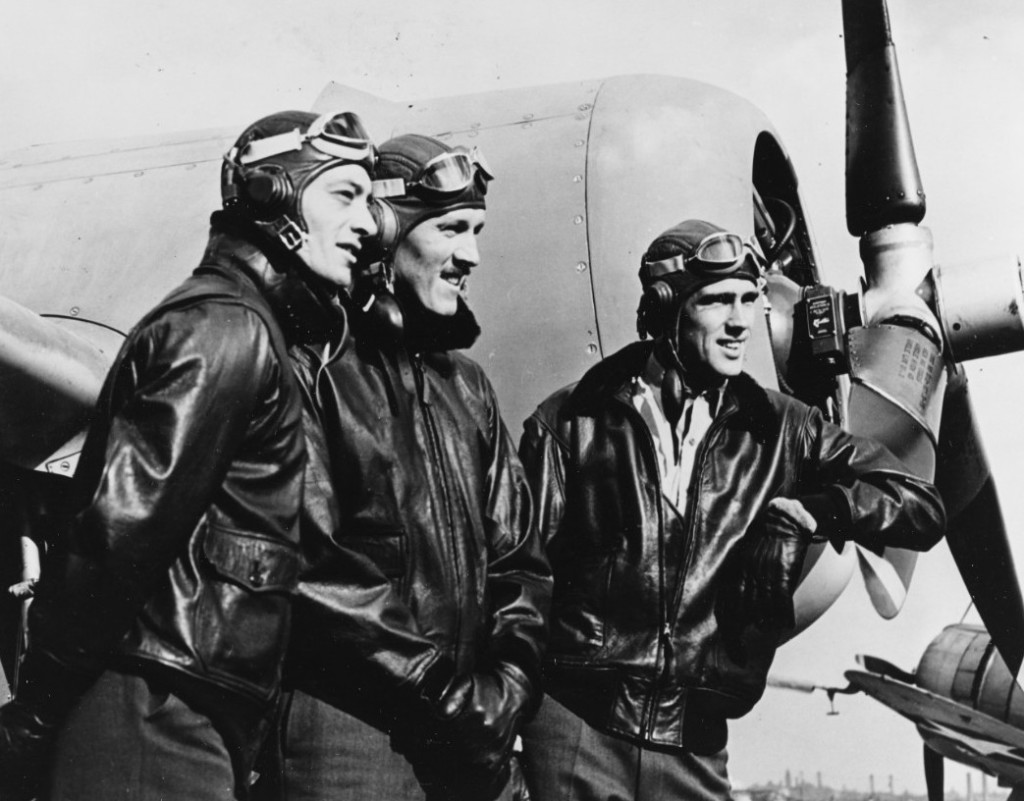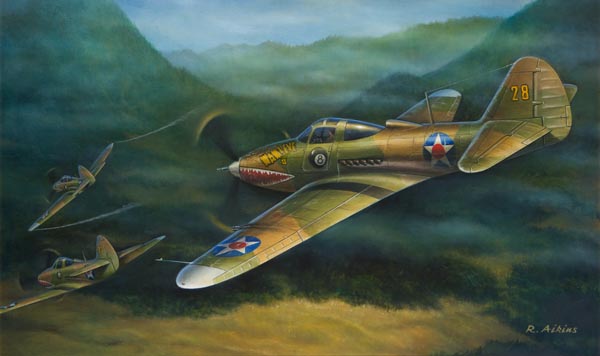Blown Slick Series #13 Part 15 (4/4)
“…the only place on Earth where you could stand up to your knees in mud and still get dust in your eyes.” Marion Carl
First Marine Ace by Roy Grinnell. Capt. Marion Carl over Henderson Field – the first Marine Ace of WWII, finishing with 18.5 kills. Awarded the Navy Cross.
Commander in Chief, United States Fleet (COMINCH) and Chief of Naval Operations (CNO) Ernest King pushed hard in Washington for operations in the Pacific – Navy ops. The victory at Midway gave him the leverage he needed in the Europe first Washington D.C. comings and goings. King directed Commander in Chief, U.S. Pacific Fleet and Commander in Chief, Pacific Ocean Areas, Chester Nimitz to move out and thus began the push to move to the offensive by invading Guadalcanal. The number of ships would grow close to ninety, vastly more than say the Wake Island or Doolittle events. As noted previously it combined land, sea and air combat capability as never before. Watchtower was indeed a recognized gamble, and yet, the planning was seriously short of consideration of that complexity and what situations might evolve, not the least of this would be the lack of early land based air.
There is no Japanese defeat in the Solomons without the defense of Henderson Field and the combat flying of the Cactus Air Force.
Henderson Field and the Beginnings of the Cactus Air Force
The Situation
The 7 August landings on Tulagi and Guadalcanal at Lunga Point, included the capturing of a partially completed Japanese airfield. Indeed, the uncompleted Japanese airfield was the reason the Americans landed on Guadalcanal in the first place.
With VADM Frank Jack Fletcher’s decision to move his three carriers farther away from Guadalcanal after the initial amphibious landings, which deprived the U.S. invasion force of close air cover, and with Rear Admiral Kelly Turner’s heaviest escorts sunk by the Japanese off Savo Island, the transport and supply ships unloaded as much as they could as fast as they could, but many supplies and much equipment was still aboard the ships when they departed. Because the concept of “combat loading” was still in a learning phase, much of what did get ashore was a hodgepodge, strewn up and down the landing beach. Because the ability to offload from boats exceeded the capacity to get the supplies off the beach, the Marines ashore were left with about four days’ worth of supplies.
Fortunately for the Marines, there was minimal Japanese opposition in the first weeks on the island. Most of the Japanese on the island had been construction troops who were in the process of clearing land for use as an airfield, and who had fled into the jungle, where without supplies of their own they quickly became mostly combat-ineffective (but still executed some deadly ambushes).
Marines immediately took over the task of finishing the airfield mainly using captured Japanese equipment. The Marines named the airstrip Henderson Field, after Major Lofton Henderson, who had been commander of the Marine bombing squadron based on Midway Island, and who had been shot down and killed while trying to attack the Japanese carrier force in the first hours of the Battle of Midway on 4 June. On 12 August, the first landing was made on the airstrip by a U.S. Navy PBY Catalina flying boat and by 18 August, Henderson Field was ready for operation
Japanese reinforcement efforts began on 16 August, as Japanese destroyers began landing troops and supplies on Guadalcanal at night. This would set the pattern for the first months of the battle. Japanese destroyers (and their own versions of destroyer-transports) would arrive at night to offload troops and supplies, generally unmolested by the U.S., with the intent to be far enough back up the Solomon Island chain by daylight to avoid being attacked by U.S. carrier or Henderson Field based aircraft. During daylight hours, Japanese land-based bombers, escorted by Zero fighters, would fly from airfields in the northern Solomons to try to strike U.S. carriers, bomb the Marines on Guadalcanal, or sink any U.S. ships attempting to resupply the Marines ashore. By the end of August, the pattern was essentially that the Japanese owned the night at sea. Control of the sky during the day was hotly contested with heavy losses in aircraft on both sides, but any Japanese ships caught in daylight were vulnerable to U.S. attack.
The airfield
When the first planes began arriving on 20 August, the airfield could barely be described as an airfield. It was an irregularly shaped blob cut out of the island growth, half in and half out of a coconut grove, with a runway that was too short and few revetments to protect the aircraft from shrapnel.
Map and picture of the airfield at Lunga point and the “Pagoda operations center.
The runway was 2,400-foot long gravel surface with an extra 1,000 feet of Marston Matting that was frequently pockmarked with craters from Japanese artillery and naval gunfire. The strip was in such poor condition that it caused as many losses to aircraft as enemy action. In the heat, the field was a bowl of black dust which fouled the warplanes’ engines. When it rained, the airfield quickly turned muddy, miring planes in liquid muck. The heavier SBD dive bombers had it the worst, since their hard rubber tires, designed for aircraft carrier landings and take-offs, ripped up the runways like plowshares. The runway was extended and widened several times during the long Guadalcanal campaign, and by 4 September it was 3,800 feet long and 150 wide.
Henderson Field was also very close to the thinly-held lines of the U.S. First Marine Division, so security was always a concern. There were no fuel trucks, aircraft hangars, or repair buildings. Damaged aircraft were cannibalized for spare parts, and with no bomb hoists, all aircraft munitions had to be hand-loaded onto the warplanes. Fuel, always critically low, had to be hand pumped out of 55 gallon drums. Even after the arrival of fuel trucks, aviation gasoline still had to be hand-pumped into the trucks.
(On 9 September 1942, the 6th Naval Construction Battalion (SeaBees) opened up a second runway about one mile to the east of the original runway. This new runway, called “Fighter 1”, consisted of tamped-down sod, and it was about 4,600 feet (1,400 m) long and 300 feet (91 m) wide. The Marine fighter squadrons began operating out of Fighter 1, with the rest of the aircraft operating out of the original runway – thereafter referred to as “Bomber Field No. 1.”)
Living conditions on Guadalcanal were some of the most difficult ever faced by Marine aviation. Pilots and mechanics lived in mud-floored tents in a flooded coconut plantation called “Mosquito Grove.” Most contracted tropical diseases such as malaria, dysentery, dengue fever, or fungal infections.
The misery was accompanied by mortal danger. The airfield was bombed nearly every day around noon by 20 to 40 Mitsubishi G4M “Betty” bombers flying at 20,000 feet (6,100 m) in a perfect “Vee formation” escorted by fighter planes. It was frequently shelled as well, by Japanese artillery in the day and Japanese warships at night. (The worst night of bombardment was on 13–14 October 1942, when two Japanese battleships fired more than 700 heavy shells into the airfield, providing cover for the Japanese Navy’s landing of Marine and army reinforcements further west on Guadalcanal.)
The Cactus Air Force
The first Marine aircraft arrival on 20 August included part of Marine Aircraft Group 23 flying from the escort aircraft carrier USS Long Island and included 18 F4F Wildcat fighter planes of VMF-223 led by Major John L. Smith and a dozen SBD Dauntless dive bombers of VMSB-232 led by Lt. Colonel Richard Mangrum. They conducted combat missions the following day.
Major John L. Smith, Lt. Colonel Richard Mangrum, and Capt Marion Carl.
The Marines had occupied Guadalcanal for thirteen days prior to VMF-223’s arrival and fighting had been limited to sporadic firefights, but the staff of the 1 st Division knew that a major counterattack by the IJA was imminent. That attack came at 0240 on the morning of 21 August when a force of over 900 Japanese soldiers crossed the Tenaru River from the east and slammed into the eastern perimeter guarded by 2nd Battalion, 1 st Marines whose defensive positions were only three thousand yards from the airfield. They blocked the attack and maintained its perimeter intact, but at daybreak, the Japanese force attempted to outflank the defending Americans by boarding assault boats and moving out to sea just beyond the breakers, landing again a few hundred yards west of the defense.
Early on the morning of 21 August, 1 st Division headquarters directed Captain Smith, commander of VMF-223 to provide close air support (CAS) to 2/1 along the shoreline adjacent to the Tenaru River. Smith immediately took the information and map and ran to his squadron flight line, where Captain Loren D. Everton and three others were in their F4Fs, warming up the engines. Smith showed the map to Everton, explained the situation to him, and directed him to “go out, investigate, and use your own judgement about strafing or returning.”. He quickly departed the airfield with the other three Wildcats and located the Japanese still in their boats approaching the shore.
The four F4Fs made short work of the fragile boats, spoiling the Japanese counter move. What Everton’s flight did not destroy in the sea was annihilated by 2/1 when it reached the beach. The Japanese attack was halted; the remaining soldiers quickly withdrew into the jungle to the east.
21 August also brought the first Marine air-to-air combat, with mixed results. Japanese Zeros from the Tainan Air Group on a bomber escort mission (the bombers were fruitlessly searching for American carriers south of Guadalcanal) passed over Henderson Field on their way back to Rabaul, and six of these were met by four Cactus Air Force F4F Wildcats at 14,000 feet. Major Smith claimed the first air-to-air victory for the CAF, but two other pilots crashed while landing their damaged aircraft, with both of the Wildcats deemed a total loss except for salvaged parts. That same night, an SBD Dauntless blew a tire on take-off, causing it to ground loop and crash for another aircraft loss.
They were joined on 22 August by the U.S. Army’s 67th Pursuit Squadron under Major Dale Brannon, with five Army P-400s (an “export” version of the P-39); and on 24 August by 11 SBD dive bombers that came from the aircraft carrier USS Enterprise which were unable to land on their carrier, damaged in the Battle of the Eastern Solomons.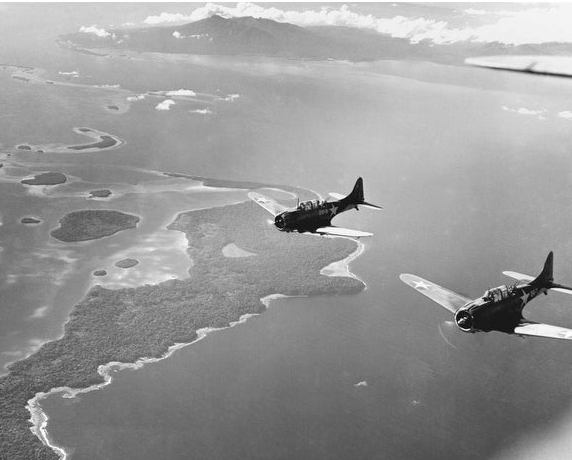
At the end of August, these warplanes were joined by 19 more Wildcats from VMF-224 under Major Robert E. Galer, and a dozen more SBD dive bombers from VMSB-231, also part of the Marine Air Group 23. This varied assortment of Army, Marine, and Navy pilots and warplanes was the beginnings of the Cactus Air Force. (“Cactus” was the Allied code name for Guadalcanal).
On 24 August, during the carrier Battle of the Eastern Solomons, Japanese Vice Admiral Chuichi Nagumo sent the Imperial Japanese Navy (IJN) light carrier Ryujo ahead of the main Japanese warship force as an aircraft attack force against Henderson Field. The Ryujo mission was most likely in response to a request from Nishizo Tsukahara, the naval commander at Rabaul, for help from the Japanese combined fleet in neutralizing the land based air threat. At 12:20 and 200 miles northeast of Guadalcanal, the Ryujo launched six “Kate” bombers and 15 A6M Zero fighters to attack Henderson Field in conjunction with an attack by 24 “Betty” bombers and 14 Zero fighters from Rabaul.
Unknown to the Ryujo force, however, the Rabaul aircraft had encountered severe weather and returned to their base at 11:30. The Ryujo’s aircraft arrived over Henderson Field at 14:23 and tangled with 14 Marine Wildcats and four Army P-400s while bombing the airfield. In the resulting engagement three Kates, three Zeros, and three Marine fighters were shot down with no damage done to Henderson Field. Two Marine pilots were killed in the engagement as well as eight Japanese aircrewmen. All of these Japanese aircraft were eventually lost because, while they were attacking Henderson Field, the Ryujo was sunk by aircraft from USS Saratoga, forcing the Japanese aircraft to ditch in the ocean upon returning to the previous location of their carrier. With Enterprise unable to recover aircraft due to battle damage, her aircraft landed at Henderson and continued as “part” of the Cactus AF.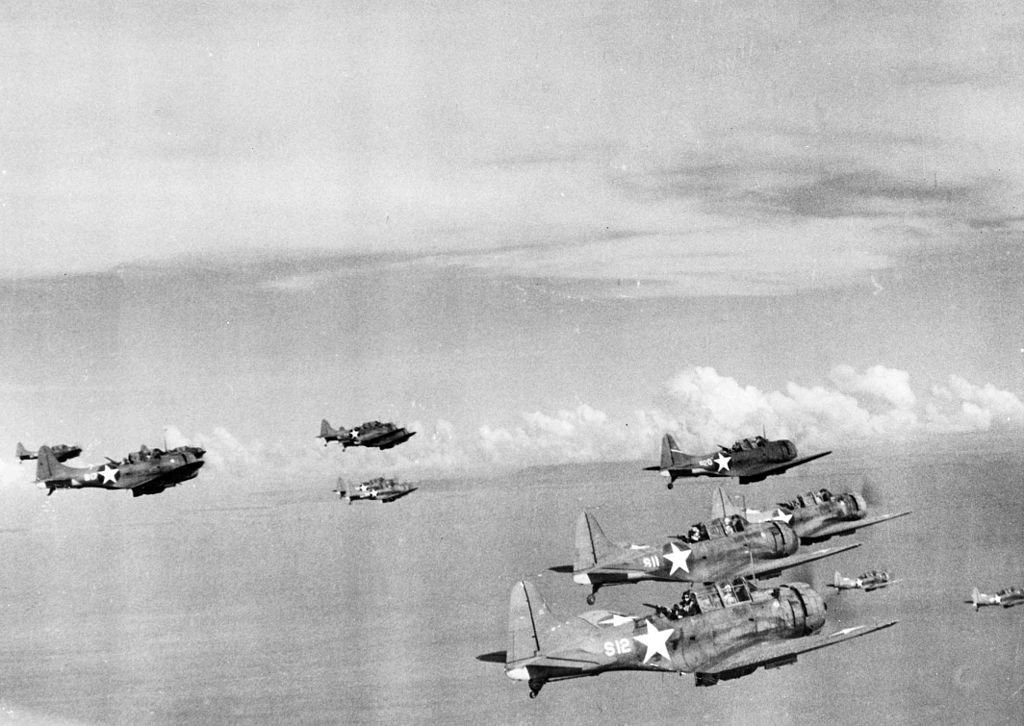
By the end of August, only five of the Wildcats and four P-400s were still flyable. However, the number of aircraft based at Henderson gradually increased and continued as a constantly changing mix of mostly Marine, Navy and some Army Air Force fighter, dive bomber, and a few torpedo bomber aircraft, including carrier aircraft from remnants of Torpedo 8 flown off the USS Saratoga [CV-3] after she was torpedoed by a Japanese submarine. Since she was forced to return to Pearl Harbor for drydock repairs, most of the Saratoga’s aircraft and aircrewmen remained behind at Espiritu Santo and Admiral McCain sent some of these aircraft to reinforce the Cactus Air Force at Guadalcanal.
By 3 September, the day of General Geiger’s arrival, the CAF consisted of only 64 flyable airplanes. Due to the continued heavy losses, Admiral McCain decided to immediately deploy the USS Saratoga’s fighter squadrons to Guadalcanal and on 4 September 24 F4Fs of VF-5 flew from Espiritu Santo to Henderson Field.
Air battles between Japanese fighters protecting Japanese bombers and U.S. fighters were an almost daily occurrence in the skies over Guadalcanal, interrupted only by weather and the extreme range that Japanese aircraft had to fly to reach the island. The Japanese would also frequently send a float plane or a bomber to harass the Marines at night; although annoying, these night flights were rarely effective.
Between 21 August and 11 September, the Japanese raided Guadalcanal a total of ten times, losing 31 aircraft and seven more heavily damaged, primarily due to the defensive efforts of CAF fighter planes. Most of the Japanese aircrewmen in the destroyed aircraft were killed. From 1 September through 8 September the Japanese aviation units at Rabaul concentrated on providing air cover for Japanese Army forces operating along the Kokoda Track on New Guinea, but they resumed air operations against Henderson Field on 9 September. During this period, the CAF Marine Corps fighter squadrons lost 27 aircraft with nine pilots killed.
As the battle for Guadalcanal continued, USMC and AAF aircraft losses mounted. On 10 September, only eleven F4Fs, twenty-two SBD dive-bombers, and three P-400s were available for the next crucial CAS mission on 14 September during the defense of Bloody Ridge.
Only two thousand yards to the south of Henderson Field lay Bloody Ridge where Lieutenant Colonel Merritt A. Edson’s 1st Raider Battalion had established a last line of defense against an expected Japanese attack out of the jungles to the south. What Edson’s battalion did not know was that a Japanese brigade over 2,000 strong was preparing to attack on the night of 13 September. The Japanese attackers mounted two major assaults before midnight. Edson’s Battalion bent but did not break, falling back a few yards at a time into successive positions along the ridge toward the airfield. If the Japanese could break the thin Marine line, the airfield would be theirs for the taking.
Before sunup on 14 September, an officer from the 1st Raider Battalion met with the commander of the 67th FS, Captain Thompson. Using a crude map, he described the precarious situation and requested a CAS mission at first light. Thompson agreed and had his flight of three P-400s at the end of the runway just before sunup. As dawn began to break, Thompson’s flight departed.
Bloody Ridge was located almost within the aircraft traffic pattern around the airfield and Thompson kept the Marine position in view as his aircraft lifted off the ground and began a slight turn to the south. Maintaining altitude just above the trees, Thompson led his flight below the level of Bloody Ridge and pointed at the suspected Japanese assembly area. When the area came into view, Thompson spotted large groups of Japanese soldiers massing for an attack and he immediately began to fire.
After two passes, Thompson’s and another aircraft, piloted by Lieutenant B. W. Brown, were critically damaged by small arms fire and had to make emergency landings back at the airfield while the third P-400, piloted by Lieutenant B. E. Davis, continued to strafe until out of ammunition.
The Japanese attack was repulsed by the iron defense of the 1 st Raider Battalion, but Thompson’s CAS mission had thrown the final weight that broke the Japanese assault. Later that afternoon, Vandegrift visited Thompson, Davis, and Brown saying, “You’ll never read it in the papers, but that three P-400 mission of yours saved Guadalcanal.”
As with Everton’s CAS mission on 21 August, the CAS mission by the 67th FS was successful despite a lack of better coordination. Had the units been further away from the airfield, the situation might have differed from what was briefed to Thompson that morning. Only a dedicated liaison team and direct ground-to-air communications would be able to redirect a CAS mission based on changes in the tactical situation.
While Guadalcanal allowed Marine, Navy, and Army Air Corps pilots to provide the first CAS in the Pacific Theater, communications capability and doctrine were far short of allowing CAS to be routinely utilized. Ground requests went directly to the Division located at Henderson Field, which processed them and passed the information along to the aircrews. The pilots briefed the target specifics before takeoff, and they often walked up to the front lines themselves to observe the next target before a mission.
Higher priority tasking subverted much of the CAS mission and development during the first ‘part of the war, such as air superiority and the support missions of reconnaissance and bombing Japanese shipping. This often forced the Marine aviators to provide protection rather than focusing on the needed CAS mission. While Guadalcanal CAS was indeed rudimentary, the lessons learned led to significant developments in the air/ground relationship for operations later in the war.
****************************
The Cactus Air Force mix of Marine, Navy and Army Air Corps aircraft would persist throughout the Guadalcanal Campaign, playing a major role in the 11-15 November Naval Battle of Guadalcanal which effectively ended Japanese efforts to retake Guadalcanal.
Cactus dive bombers and torpedo planes sank or destroyed 17 large enemy vessels, including one Japanese battleship, one heavy cruiser (the Kinugasa), one light cruiser, three destroyers, and twelve transports, possibly sank three destroyers and one heavy cruiser, and heavily damaged 18 other ships, including one heavy cruiser and five light cruisers. Most notable was the battleship Hiei, which the CAF, along with aircraft from the Enterprise, and B-17s from Espiritu Santo, finished off after she had suffered serious damage from American cruisers and destroyers during the Naval Battle of Guadalcanal.
The fifteen Marine combat squadrons that fought on Guadalcanal during this time suffered 94 pilots killed or missing-in-action, with another 177 evacuated with wounds or with sickness (especially severe malaria). Total figures for Japanese aerial losses during the Guadalcanal campaign have never been calculated.
The Battle of Guadalcanal would become the defining point for Marine Corps aviation in World War II and for the next fifty years. The great lessons learned for Marine Corps aviation units were the debilitating effects of not having air superiority; the importance of the use of radar; the vulnerability of enemy transport and warship targets; the need for communications, training and doctrine for CAS; and the vital importance of quickly acquiring expeditionary airfields during amphibious operations.
For aerial performance at Guadalcanal The Medal of Honor was awarded to:
- LtCol. Harold W. Bauer
- Capt. Joe Foss
- Maj. John L. Smith
- Maj. Robert E. Galer
- First Lt. Jefferson J. DeBlanc
Next Part #13 – The Battle of the Eastern Solomons


